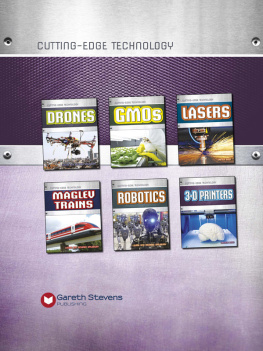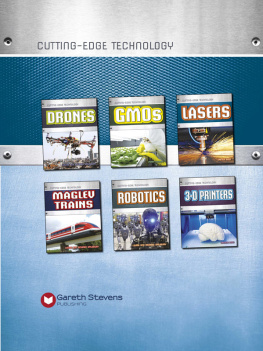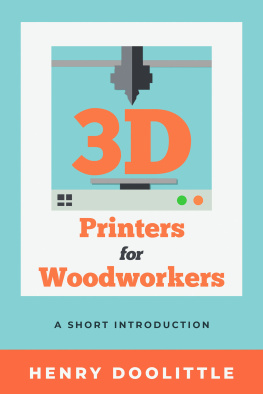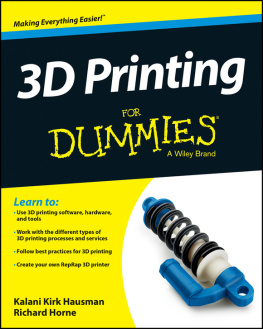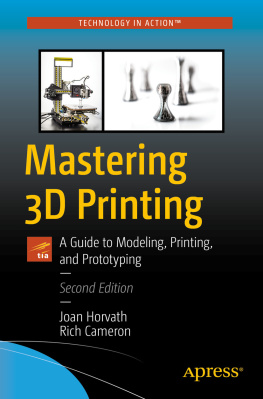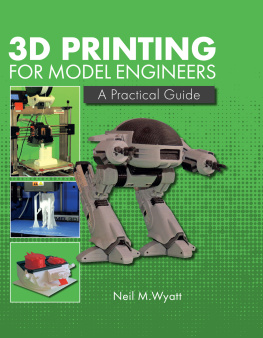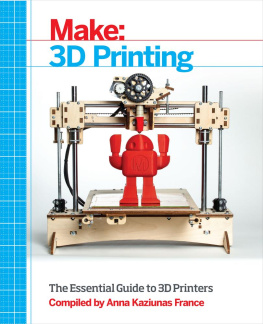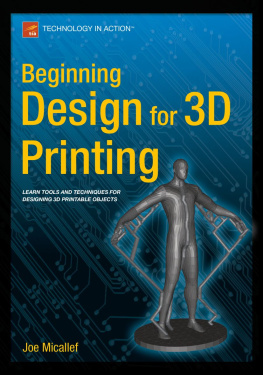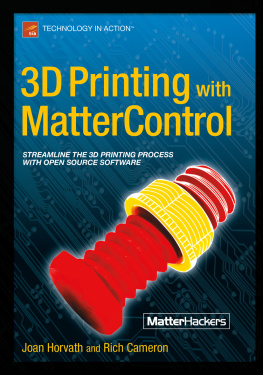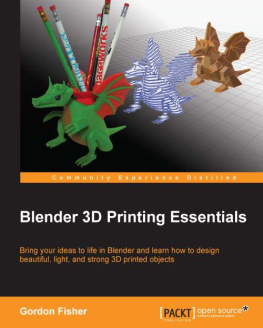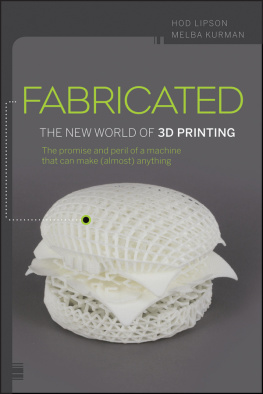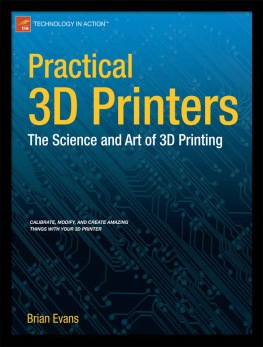Page List

Please visit our website, www.garethstevens.com.
For a free color catalog of all our high-quality books,
call toll free 1-800-542-2595 or fax 1-877-542-2596.
Cataloging-in-Publication Data
Names: Bow, James.
Title: 3-D printers / James Bow.
Description: New York : Gareth Stevens Publishing, 2017. | Series: Cutting-edge technology | Includes index.
Identifiers: ISBN 9781482451672 (pbk.) | ISBN 9781482451610 (library bound) | ISBN 9781482451498 (6 pack)
Subjects: LCSH: Three-dimensional printing--Juvenile literature.
Classification: LCC TS171.8 B69 2017 | DDC 621.988--dc23
First Edition
Published in 2017 by
Gareth Stevens Publishing
111 East 14th Street, Suite 349
New York, NY 10003
2017 Gareth Stevens Publishing
Produced for Gareth Stevens by Calcium
Editors: Sarah Eason and Harriet McGregor
Designer: Jessica Moon
Picture researcher: Rachel Blount
Picture credits: Cover: Getty Images: Gnay Mutlu (photo), Shutterstock: Eky Studio (banner), Shutterstock: R-studio (back cover bkgrd); Inside: Flickr: Creative Tools (CC BY 2.0) 1, 39, Bre Pettis (CC BY 2.0) 5, U.S. Army RDECOM (CC BY 2.0) 41; Shutterstock: ArtThailand 13, Lucadp 36, Dario Sabljak 29, Sspopov 11, Stefano Tinti 17, 23, WeStudio 21; Wikimedia Commons: Jost Amman 9, Globaloria Game Design (CC BY-SA 2.0) 45, HIA (CC BY-SA 3.0) 30, Fred Hsu (CC BY-SA 3.0) 33, Jynto (CC0 1.0) 42, Philip James de Loutherbourg/The Yorck Project 7, Makerbot Industries (CC BY 2.0) 27, Saskia2586 (CC BY-SA 3.0) 35, Stephen Shephard (CC-BY-SA-2.5) 19, Studio Under (CC BY-SA 3.0) 25, S Zillayali (CC BY-SA 3.0) 14.
All rights reserved. No part of this book may be reproduced in any form
without permission from the publisher, except by reviewer.
Printed in the United States of America
CPSIA compliance information: Batch #CS16GS: For further information contact Gareth Stevens, New York, New York at 1-800-542-2595.
CONTENTS
T his book looks at three-dimensional (3-D) printers, a technology that could revolutionize the way things are made. 3-D printers allow designs to be downloaded from the Internet and printed in your own home. Anything can be printed, from plates and cups to artificial limbs.
CHANGING LIVES
3-D printers are changing lives throughout the world. People in developing countries often have little money and may be far from roads that can transport goods. By introducing 3-D printers to these countries, the people there can make what they need rather than having to buy it and have it transported to them.
Po Paraguay, in Paraguay, is an organization that is changing peoples lives by using 3-D printing. It is a nonprofit organization set up to provide prosthetic limbs at low cost. It uses a 3-D printer to create the limbs, making them more quickly and for less money than would be possible with other machines.
CUTTING EDGE
In 2014, a young girl named Lalyz moved the fingers on her right hand for the first time. Born without a hand, her parents took her to Po Paraguay. Lalyzs arm was scanned with a laser that took measurements of the arm. Then a 3-D printer laid down thin layers of plastic to the measurements taken and produced parts of a hand. Once cooled, these parts were put together to make a hand with moving fingers.

Plans for this MakerBot 3-D printer can be downloaded, allowing the user to build their own 3-D printer.
THE MAKING MACHINE
T he journey to the creation of 3-D printers has been a long one. In the early days of civilization, when people wanted to make things, they used materials from the world around them. They wove small branches into walls. They broke larger branches to make fires. They figured out that mud could be mixed with water and left to dry to form bricks. They found that if they heated the mud in hot ovens, it became even harder and could be used to make pottery.
TOOLS
Making objects was slow work. Objects were produced one at a time, and many people were needed to make objects in large quantities. Over time, people learned how to improve their methods as they worked. They discovered that by using tools made from sticks and stones they could work more quickly and more easily.
MACHINES
Eventually, the tools people used became machines that required power to provide the energy to do work. The earliest machines used water for power to turn wheels. Then people figured out how to boil water and use the steam for power to push presses that could shape metal. This was the start of the Industrial Revolution, which began in the 1700s.
By the early nineteenth century, the Industrial Revolution had changed the world through the invention of machines. Because machines could quickly do work that would once have taken dozens of people a long time to do, more people had time to work on other things. People invented new technologies and made more goods. Peoples lives became better and more comfortable.

The 1801 painting Coalbrookdale by Night by Philip James de Loutherburg shows the furnaces and big buildings needed to make things at the start of the Industrial Revolution.
INDUSTRIAL REVOLUTION
The Industrial Revolution brought about changes that benefitted people, but it also brought changes that were not so good. The machines needed to make goods were big and could only operate in large factories. People had to buy goods produced by the factories, rather than make them themselves. This took away the power of people to produce what they needed individually. New, small 3-D printers now promise to give back this power.
2-D PRINTING
A two-dimensional (2-D) printer is a printing press. Ink is rolled on blocks of metal that have been molded into letters. Paper is put over the inked letters and pressed against it, moving the ink onto the paper. The technology was invented in China and brought to Europe by the German Johannes Gutenberg (c.1390sc.1468) in 1439. The technology allowed him to print books quickly and at low cost. One of the first books Gutenberg printed was the Bible.
Gutenbergs printing press changed the world. Before the press, books were made by hand. Monks would spend days copying text and drawing pictures, and they could only work on one book at a time. This meant that a handful of people had a lot of control over what was written and what was read. Gutenbergs press could print dozens of books in one day. Suddenly, there were more books to read, and more people started reading.
IDEAS SPREAD
With the invention of the press, ideas could be printed and passed around to a lot of people. Members of the Catholic Church wanted to control what people read. They tried to ban some books to keep people from reading them. However, the printing press had changed the world and it could not be changed back. People began to print newspapers and send letters. The printing press put many new scientific and political ideas into peoples hands.

